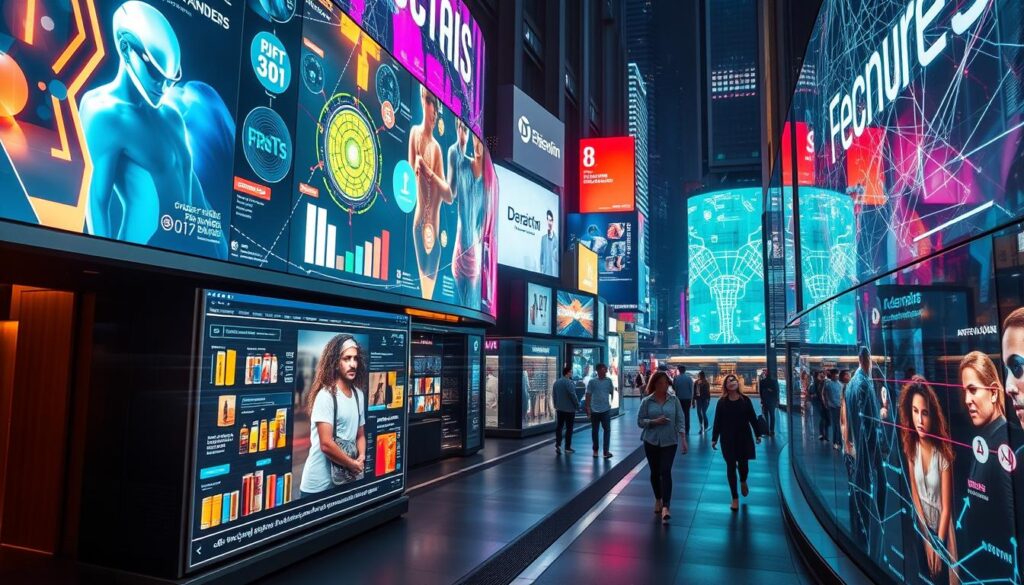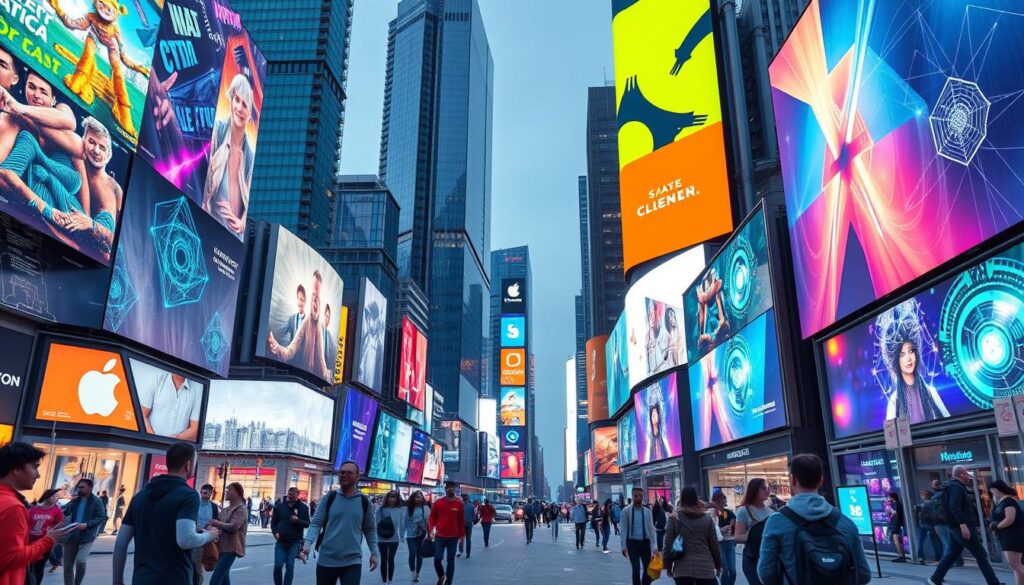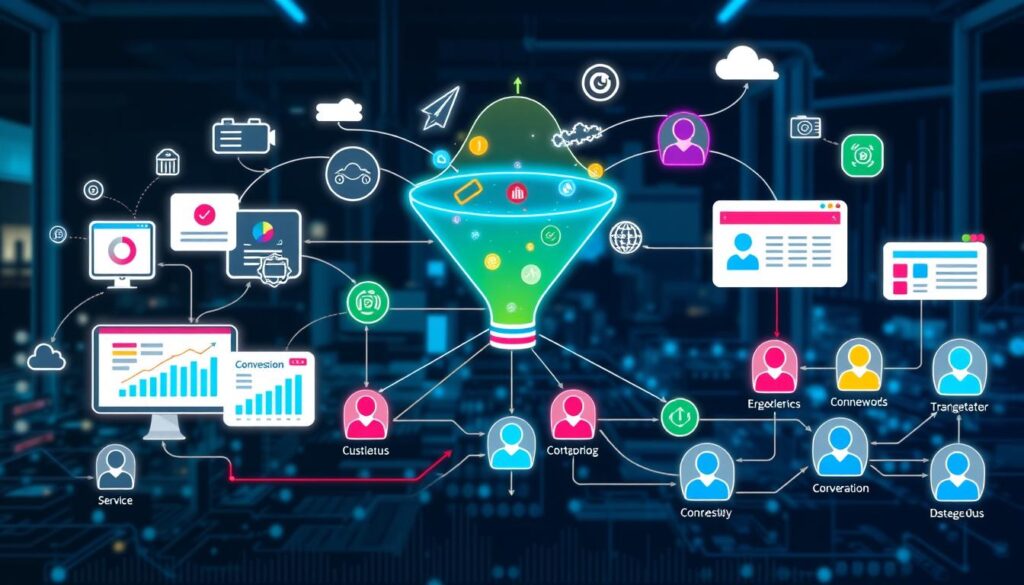In the busy world of online shopping, hesitating can be costly for brands. Thousands of potential buyers visit a site, only to leave without buying anything. About 70% of online shoppers don’t complete their purchases, leaving companies struggling. This raises a big question—how can we turn quick interest into lasting connections? AI in advertising offers a solution. It uses smart retargeting to win back those interested shoppers. By doing so, it presents personalized content that touches their hearts.
Seeing the true value of machine learning in advertising is not just about numbers. It’s about making genuine, deep connections. With AI getting better, it’s clear how much we need clever advertising. Using AI, businesses can grow their income and connect with customers in new ways. The AI market is expected to reach over $1.8 trillion by 2030. This fact encourages brands to quickly adopt AI to improve their profits.
Next, we’ll look at how AI changes the advertising game and how it leads to real customer interest. We will also talk about why making decisions based on data is important.
Key Takeaways
- AI in advertising enhances customer engagement through personalization.
- Smart retargeting strategies can recover lost opportunities effectively.
- Machine learning in advertising boosts conversion rates significantly.
- Embracing AI technologies is essential for future business growth.
- Data-driven strategies reduce ad waste and increase ROI.
- Adapting to consumer behavior is key in a competitive market.
Understanding the Power of AI in Advertising
The impact of artificial intelligence is growing in advertising. It helps marketers understand complex consumer data better. This makes it easier for them to engage customers more effectively. A piece from Harvard Business Review highlights that marketing benefits a lot from AI.
AI algorithms can look through huge amounts of data from different places. These places include social media and website visits. They find out what consumers like. This helps advertisers make ads that speak directly to what people want. For example, AI makes buying ad space in real-time easier. This increases sales and makes the money spent on ads worth it.
AI also lets companies send content that matches what users do and like. This makes customers happier and more likely to keep buying. AI chatbots and helpers provide quick answers and advice. This is a cheap way for companies to keep talking to their customers.
Natural Language Processing (NLP) helps advertisers get what customers feel from their comments and social media. Predictive analytics powered by AI can guess future behaviors and spot trends. This insight helps companies make smart choices early, staying ahead of their rivals.
As companies test AI in ads, they see it changes how traditional ads work too. Better targeting means ads sent through the mail are more likely to be welcomed. This grabs the attention of certain groups more effectively.
AI speeds up creating ads and brings new ideas for designs. Marketers can handle more projects with AI tools. This shows how combining creativity with technology can be good for business.
Companies using AI in ads will likely see more people interested in what they offer. They’ll target customers better and see more sales. This sets them up for success in today’s digital world.
The Role of Machine Learning in Advertising
Machine learning is now a key player in advertising. It changes how ad campaigns are planned and launched. By using a lot of data, it improves data analysis in advertising. This helps companies do better in their advertising efforts.
This tech processes complex data fast. It also finds insights that humans might miss. This was a challenge before due to our limits.

Today, over half of the data in advertising is not used. This is because of not enough tools, too much data, and scattered systems. Orchid Richardson of the IAB’s Data Center of Excellence says 95% of advertisers have useful data. This includes details on demographics, location, and interests. Machine learning can make use of this data better. This improves how ad campaigns perform.
Machine learning spots revenue chances that old methods could miss. At the VentureBeat Transform 2018 AI Conference, Julie Shumaker showed examples. Machine learning found new groups to target, which helped make more money. Bidalgo’s “Creative AI” looks at past ads to see what works best with people. This ranges from the message to how the ad looks.
Personalization is key today. Machine learning gives marketers tools to reach out more effectively. Research in the Journal of Consumer Psychology shows that algorithms can match images with personality types. This helps create stronger marketing strategies. Machine learning also sees what works best, like how certain colors do better at night or how sports ads do on weekends.
Machine learning also automates marketing jobs. It makes content and audience targeting better, improving customer experiences. These systems learn and adapt over time. This helps in making data-driven choices, likely leading to better ROI.
In conclusion, machine learning is changing advertising for the better. It enables smarter decisions through its power to analyze data. As more businesses use this tech, the chances for better advertising efficiency grow.
| Application | Description |
|---|---|
| Audience Segmentation | Utilizes user data to identify distinct customer segments for personalized marketing. |
| Predictive Analytics | Analyzes historical data to forecast future outcomes, aiding in more strategic decision-making. |
| Dynamic Pricing | Adjusts prices in real-time based on market trends, competitor pricing, and demand. |
| Creative Insights | Evaluates past advertising materials to highlight successful creative elements. |
| Customer Service Automation | Implements chatbots and virtual assistants to enhance customer interactions and satisfaction. |
AI in Advertising and Retargeting
AI retargeting marks a big step forward in making ads more effective. It focuses on reaching out to people who have already shown an interest in a brand. By looking into how users acted in the past, AI can make ads that closely match what the consumer wants. This makes it more likely that they will take action. It’s important to note that the global average conversion rate on e-commerce sites is about 2.6 percent. This shows there’s a big chance to get better results by using smarter retargeting.
Traditional remarketing often can’t match the right product with the right person, especially after they log out. AI-based segmentation solves this by predicting what users might buy next using their data and past actions. Deep learning, used by platforms like Appier’s CrossX Programmatic Platform, helps identify users likely to buy something at the moment. This makes ads more effective.
Machine learning is key to telling apart users who are just browsing from those ready to buy. This lets advertisers focus on people more likely to make a purchase, using their web activity as a guide. AI’s ability to spot trends quickly means ads can offer what users really want.
AI improves marketing by suggesting products related to past buys across different websites. Using AI platforms like CrossX for cross-screen remarketing makes reaching people across devices easier. This speeds up the buying process. Predictive retargeting uses AI and machine learning to guess who’s most likely to buy. This boosts conversion rates by focusing on people already interested in ads.
Predictive retargeting lets companies use their budgets more wisely. They can cut down on unnecessary ad spending while getting better returns. Personalized ads, made possible by AI, increase user engagement and conversion rates. This approach improves the online shopping experience and helps other fields like travel and hospitality boost their success. Keeping predictive models up to date ensures they match current user behavior and market trends.

| Aspect | Traditional Retargeting | AI Retargeting |
|---|---|---|
| Conversion Rate | ~2.6% average | Increased through predictive targeting |
| Segmentation | Basic, often inaccurate | Data-driven, precise |
| Behavioral Analysis | Difficult tracking post-logout | Continuous, real-time pattern recognition |
| Personalization | Static ads | Dynamic, tailored recommendations |
| Budget Efficiency | Higher ad spend with less ROI | Optimized spending via accurate targeting |
Key AI Technologies Transforming Advertising
AI technologies are changing how brands view advertising. They bring new ways to enhance digital marketing effectiveness. Machine learning, natural language processing, and computer vision are key in this transformation.
Machine Learning (ML) lets brands sort through big data on consumers. This results in better targeted ads. For example, Lego Systems used Watson Ads Omni for AI-driven campaigns on Black Friday. This shows how ML improves ad results and connects brands with consumers directly.
Natural Language Processing (NLP) changes how brands talk to customers. It uses AI to understand consumer chats, making marketing more personal. BEHR Paint uses AI to recommend colors based on mood. This makes choosing products easier and more fun for customers.
Computer Vision boosts visual ads by analyzing images for targeted marketing. Using AI, brands get insights from pictures that help shape future ads.

Ads powered by AI get up to six times more engagement than standard digital ads. This shows AI’s success in grabbing attention and sparking interest. Also, AI helps save money on ad spending, making budgets work smarter.
AI tools in advertising are becoming more popular. They help analyze campaigns and guess who will watch them. Brands that use tools like Watson Ads stand out by making their ads smarter and connecting with consumers on a deeper level. This makes digital marketing better and sets the stage for new developments.
Natural Language Processing: Revolutionizing Customer Interaction
Natural Language Processing (NLP) is changing how companies talk to customers. By understanding feelings and sending personalized messages, businesses can improve their strategies. They can connect better with people. NLP helps figure out what customers think about them from social media and reviews. This knowledge is key for brands. It helps them match their campaigns to what people like.

Sentiment Analysis in Marketing
Sentiment analysis is a big part of NLP. It lets companies know what people think of them. By looking at what customers say, brands learn about hot topics and what kind of content people prefer. This helps make their content better and interaction closer. For instance, using sentiment analysis can boost customer interest by 30%. Companies find such information vital for making ads that really speak to people.
Personalized Messaging through NLP
Personalized messages significantly help in keeping customers interested. NLP studies how users behave and what they like to offer messages that hit the mark. This strategy enhances both customer attraction and happiness. Companies using NLP for their chatbots see big gains. They deliver instant help for over 80% of customer questions. This slashes waiting times and lowers costs. It shows how crucial advanced NLP is in today’s marketing.
Computer Vision: Enhancing Visual Advertising
Computer vision is key in transforming visual advertising. It analyzes images and videos, helping brands grasp how consumers behave. With this tech, companies see how users interact with visuals. This offers insights for more engaging ads.

Its big win is making ads personal. This makes ads more interesting and relevant. With visual search, finding products through images becomes easy, boosting sales.
Using computer vision for retargeting improves ad impact. These personalized ads nudge users about products they’ve seen before. It works by studying buyer behaviors. This leads to ads that really speak to users’ interests.
| Feature | Benefit |
|---|---|
| Real-time User Interaction Analysis | Informs marketers about which visual elements drive conversions |
| Aesthetic Qualities Assessment | Helps tailor visual content to align with consumer preferences |
| Emotion Recognition | Provides deeper insights into consumer responses |
| A/B Testing Strategies | Facilitates continuous improvement of content based on feedback |
| Dynamic Ad Content | Enhances user experiences through personalized recommendations |
Computer vision tailors images for different platforms. This ensures content meets platform needs while engaging more users. It uses data and machine learning for deep consumer insights. These patterns guide future marketing campaigns.
Also, generative AI and computer vision work together well. They produce visuals that match user tastes. This keeps the user experience smooth across all channels. It boosts brand memory and increases sales.
Programmatic Advertising: Automation at Its Best
Programmatic advertising has changed how businesses handle ad buying and placement. Through automation, marketing campaigns become more efficient and focused. AI speeds up the ad buying process, letting advertisers bid on ad spots quickly.

In the last ten years, programmatic advertising has become a top choice for buying digital media. AI lets us deliver personalized ads by looking at user data. This method makes buying ads easier, reduces waste, and cuts costs. It makes sure ads reach the right people at the best time.
- Real-Time Bidding (RTB): Advertisers compete for ad space very fast, choosing places where users are most engaged.
- Data-Driven Targeting: Algorithms analyze what users do online to make ad targeting more precise.
- Dynamic Creatives: Ads are customized on the spot, making sure they connect with each viewer.
AI can handle lots of data, helping marketers test and improve ad elements like colors and texts. This customization increases how much users interact and buy, showing how crucial programmatic advertising is today.
The commitment to programmatic advertising is growing as AI evolves. By 2028, its market could reach $38.7 billion. This highlights how vital automated advertising is for companies wanting to boost their online marketing.
Benefits of Retargeting and Remarketing
Understanding how consumers behave is key to retargeting. By analyzing consumer behavior, businesses can create more effective marketing strategies. This can lead to higher conversion rates. In fact, those who see retargeted ads are 43% more likely to buy something.
Understanding Consumer Behavior for Remarketing
Marketers use consumer behavior to spot interested leads. Remarketing uses online activity insights to bring users back and encourage a purchase. It’s noteworthy that returning visitors drive almost half of e-commerce sales. This happens while first-time visitors have a low 2.4% conversion rate. This shows remarketing’s role in engaging leads.
Success Stories in Retargeting Campaigns
Many companies showcase the impact of retargeting. Amazon boosts sales by reminding users about items they left in their carts. Audible brings back customers with special deals. Nike shows customers ads for products they’ve looked at, improving both experience and sales. Also, Facebook retargeting increases conversions by 70%, a significant leap over standard ads.

Strategies for Effective AI-Driven Advertising
Using AI in advertising makes marketing better. Surveys show that 61% of marketers now use AI. It’s clear that smarter ads are becoming more popular. Brands get better at reaching the right people and making ads that speak to them.
It’s key to know how customers act and what they like. Amazon is good at this with AI. They suggest products you might like, which feels personal. This makes customers happy and invested.

Google Ads uses AI to decide which ads show where and how to bid for spots. Facebook is great at finding who will love and click on ads by looking at user info. AI makes ads more likely to make money back and then some.
There are tools like AdCreative.AI for finding what works in ads. AdRoll improves ads you see again and makes sure they’re talking to the right people. Jasper.AI keeps marketing in line with your brand and friendly for Google.
AI saves time by automating ad stuff, making everything quicker. It predicts who will like your ads, making customers happier. Ads that feel personal can make more people interested and engaged.
But using AI can be tricky. It’s hard to know AI’s limits and to keep ads high quality. It’s also super important to check facts and not to use others’ work without permission. These are big deals in AI ads today.
Best AI Advertising Tools to Consider
Today, many businesses want to improve their ads. They use the top AI tools for this job. These tools help make campaigns that truly speak to the people they’re aimed at. Let’s look at some of the top AI advertising platforms you should think about:

- Google Ads: Famous for reaching lots of people, Google Ads uses smart algorithms to put ads in the right spots. This ensures your ads are seen by the right people.
- Facebook Ads Manager: This tool lets advertisers target very specific groups. It creates personalized ads based on how users behave online.
- AdRoll: Being around for nearly 20 years, AdRoll is great at showing ads to people who’ve visited your site before. It increases the chances they’ll come back by 70%.
- Criteo: Criteo works with over 1,000 top publishers. It makes sure ads are seen by more than 750 million people every day.
- ReTargeter: Specializing in showing users ads based on their past online activities, ReTargeter works across websites, CRMs, and search engines.
Research shows that 75% of online visitors notice ads tailored to them. Retargeting ads are ten times more likely to be clicked on. They also have a 70% better chance of making someone buy something. With just 2% of website visits turning into sales, retargeting opens up big chances for growth.
67% of companies now use AI for things like content marketing. AI makes sure ads reach the right people at the right time. It makes campaigns more effective. Plus, it can get ads out there 20% faster.
Companies aiming for real success might set goals like growing their audience by 30% in six months. Or they could try to earn 15% more from their ads over a year. Using the best AI tools in advertising will definitely change how effective ad strategies are.
Case Studies: AI Success in Advertising
Many companies have seen great benefits from using AI in their ads. These success stories show how modern tactics can really pay off.
Coca-Cola’s AI-driven personal ad campaign improved customer loyalty and increased sales.
Crabtree & Evelyn boosted their ad returns by 30% with Albert AI’s help. This shows how AI can make advertising spending more effective.
TheCultt saw a 37% jump in sales using Chatfuel’s chatbot tech. Automating chats with AI makes customer service better and boosts sales.
Bloomreach saw website traffic go up by 40% after using Jasper for content. AI helps brands grow their online presence through better content.
Stick Shift Driving Academy’s traffic and call volume soared thanks to Market Muse. Their experience underlines the value of using AI for content advice.
Itson’s investment in Recombee’s personalized emails paid off massively, jumping e-commerce sales.
Novo Nordisk got more people opening their emails by using Phrasee’s AI. This shows AI can make marketing emails more appealing.
By using Reply AI, Influencer Marketing Factory got major media mentions. This proves AI can boost public relations efforts.
Ivanti created a huge business opportunity with 6Sense. AI’s data analysis helps focus marketing efforts better.

These examples clearly show AI’s big role in enhancing advertising success. Using AI not only makes processes smoother but also creates more personal experiences for customers.
Future Trends in AI and Advertising
The future of AI in advertising is set to change the game. Companies are getting ready to pour more money into new ad tech. They aim for better personalization. Brands use AI to craft messages that really speak to people. Take Meta as an example. It uses AI to decide how often and where ads should show on Facebook and Instagram. This ensures ads match what users like.
Predictive analytics will become key in spotting new trends and making ads more effective. Brands will predict what customers might want next. Coca-Cola is ahead here, using AI to target its ads. It combines machine learning and chatbots to draw in customers.
Starbucks is making big moves with its AI platform, Deep Brew. It’s helping their rewards program thrive with 25 million active members. Starbucks expects to make nearly $3 billion from using AI smartly.
L’Oréal is exploring generative AI for social media. It’s making product photos and videos more engaging. This is part of a bigger shift. More brands will use AI to make ads that consumers can’t resist.
Platforms like Google Ads and Facebook Ads Manager rely on AI too. They’re getting smarter at placing ads to give advertisers the best bang for their buck. With the AI market possibly hitting $1.8 trillion by 2030, brands are keen to jump on board.
Conversational AI is also on the rise. Gartner sees a 24% growth by 2024, especially for chat support. Plus, AR is becoming more important. A report from Threekit shows 61% of shoppers prefer stores that offer AR experiences.

Advertising is on the brink of big changes, thanks to AI. Companies focusing on these new trends and tech will likely soar. The outlook for AI in advertising shines bright.
Conclusion
The world of ads is changing fast because of AI and smart retargeting. This brief on AI ads shows that using these new tools can really help companies connect better with people. Plus, they get more out of their ad money. By 2025, spending on AI ads could hit $158 billion worldwide. This marks a big move towards using smarter ad tech.
Companies that use AI for ads are seeing up to 30% better returns, says Gartner. With smart ads, brands find the right people more easily. This cuts down on how much they spend getting new customers by 20%. It also makes 25% more people buy something. AI lets companies change their ad plans fast, making things work better and more clear than old ways.
It’s getting really important for companies to use AI in ads if they want to stay ahead. Stores like Carrefour Taiwan are already doing great with AI to find customers again. Using AI helps brands stay on top in a world where what people want keeps changing. The key to winning in ads tomorrow is using AI wisely today. It can really boost what companies get back from their ads.










